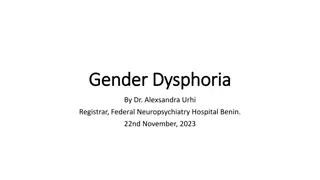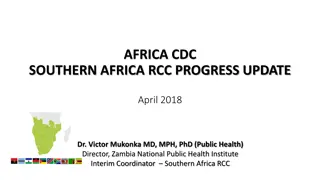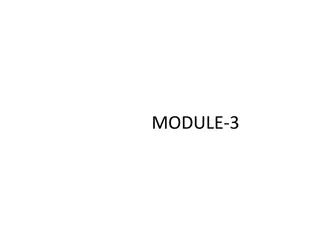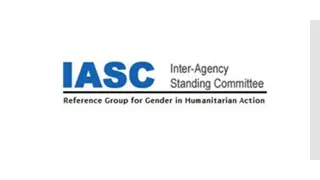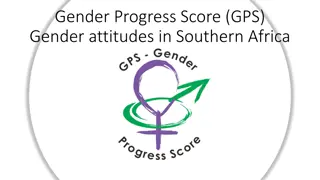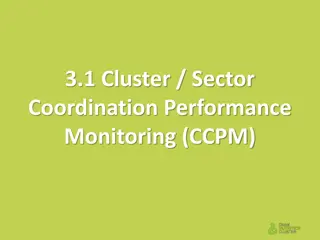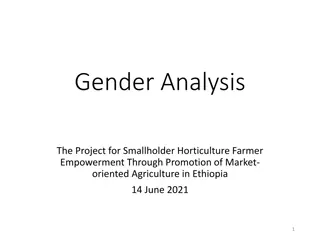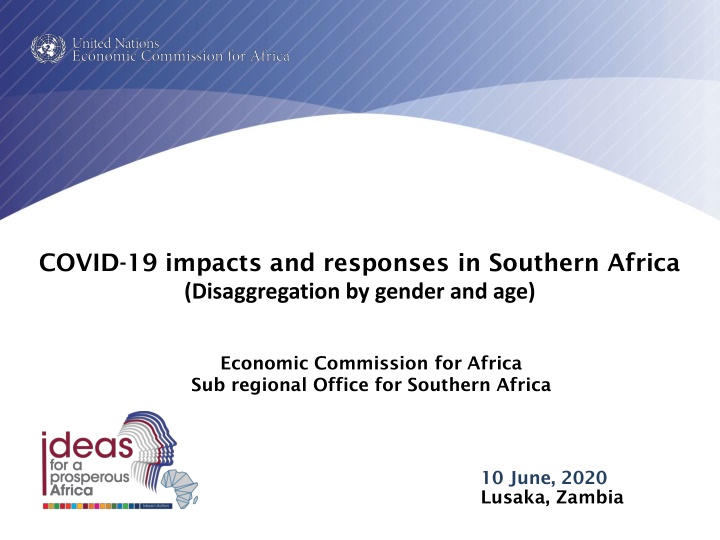
COVID-19 Impacts & Responses in Southern Africa: Situational Analysis by Gender and Age
This report delves into the COVID-19 situation in Southern Africa with a focus on gender and age disaggregation. It highlights case summaries, national responses/strategies, socio-economic impacts, and regional strategies.
Download Presentation

Please find below an Image/Link to download the presentation.
The content on the website is provided AS IS for your information and personal use only. It may not be sold, licensed, or shared on other websites without obtaining consent from the author. If you encounter any issues during the download, it is possible that the publisher has removed the file from their server.
You are allowed to download the files provided on this website for personal or commercial use, subject to the condition that they are used lawfully. All files are the property of their respective owners.
The content on the website is provided AS IS for your information and personal use only. It may not be sold, licensed, or shared on other websites without obtaining consent from the author.
E N D
Presentation Transcript
COVID-19 impacts and responses in Southern Africa (Disaggregation by gender and age) by gender and age Economic Commission for Africa Sub regional Office for Southern Africa 10 June, 2020 Lusaka, Zambia
Contents 1. COVID-19 in Southern Africa: Situational Analysis i. Summary of cases ii. Disaggregation by gender and age 2. National responses/strategies 3. Socio-economic impacts 4. SADC Regional strategies Sources: SADC Selected macroeconomic indicators (2019), SADC Responses to COVID-19, Bulletin No. 3 (2020), COVID-19 in COMESA: Situational Report (2020)
COVID-19 Tests, Infections, Deaths & Recoveries in Southern Africa COUNTRY POSITIVE CASES (CUMULATIVE) RECOVERIES DEATHS TOTAL TESTS Angola 96 38 4 12,155 Botswana 42 24 1 26,238 Eswatini 371 232 3 7,451 Lesotho 4 2 0 unavailable Malawi 455 55 4 6,690 Mauritius 377 324 10 129,768 Mozambique 453 136 2 15,190 Namibia 31 16 0 4,970 52,991 29,006 1,162 968,070 South Africa Zambia 1,235 1,020 10 37,448 46 Zimbabwe SRO-SA 314 56,369 4 54,535 1,262,515 30,899 1,200 Source: Ministries of Health Date: 09/06/2020
Botswana: Disaggregationof COVID-19 cases by gender and age group Age distribution of cases Gender distribution of cases 8 17 17 20 15 Number 10 5 1 0 0 0 0 - 9 10-19. 20 - 39 40 - 59 60+ 32 Age group Male Female Source: Ministry of Health Date: 06/06/2020 Eswatini: Disaggregationof COVID-19 cases by gender and age group Gender distribution of cases Age distribution of cases 120 Female 143 98 100 83 80 Number 60 35 33 40 22 17 Male 157 20 6 5 0 0-9 10-19 20-29 30-39 40-49 50-59 60-69 70-79 Male Female Age group Source: Ministry of Health Date: 06/06/2020
Malawi: Disaggregationof COVID-19 cases by gender and age group Gender distribution of cases Age distribution of cases 133 127 140 125 120 100 Number 80 44 60 29 40 244 10 10 8 5 20 3 0 0-5 6-17 18-29 30-39 40-49 50-59 60-69 70+ Age Missing Male Female Age group Sources: Ministry of Health Date: 03/06/2020 Mauritius: Disaggregationof COVID-19 cases by age group Age distribution of cases 93 100 90 77 80 65 70 60 Number 47 50 38 40 30 20 8 7 10 0 0-5 5-15 15-24 25-34 35-44 45-59 60+ Age group Sources: Ministry of Health Date: 04/06/2020
Namibia: Disaggregationof COVID-19 cases by gender and age group Gender distribution of cases Age distribution of cases 8 9 9 10 6 Number 5 1 0 0 17 0 0-4 5-14 15-34 35-59 60-79 80+ Age group Male Female Source: Ministries of Health Date: 04/06/2020 South Africa: Disaggregationof COVID-19 deaths by gender & age group Age distribution of deaths Gender distribution of deaths 250 210 206 375 200 149 NUMBER 150 86 417 100 69 43 50 19 5 3 2 0 Male Female 0-9 10-19. 20-29 30-39 40-49 50-59 60-69 70-79 80-89 90-99 AGE GROUP Source: Ministries of Health Date: 03/06/2020
Zambia: Disaggregationof COVID-19 cases by gender and age group Age distribution of cases Gender distribution of cases 450 402 400 338 349 350 300 Number 232 719 250 200 150 100 42 32 50 Male Female 0 0-14 15-30 31-44 45-60 60+ Age Group Source: Ministry of Health Date: 27/05/2020 Zimbabwe: Disaggregationof COVID-19 cases by gender Gender distribution of cases 117 149 Male Female Source: Ministry of Health Date: 08/06/2020
COVID-19: National Responses and Strategies Country National Response Strategies/Actions Travel Restrictions Fiscal Stimulus Monetary Stimulus Lockdown Mass Quarantine Easing of Lockdown Testing Angola no x x Botswana no x Eswatini no x x Lesotho no x x Malawi no no x NA Mauritius no x x Mozambique no x x Namibia no x South Africa x x Zambia x x Zimbabwe no x x Key: X = affirmation/yes
COVID-19 Socio-economic Impacts in Southern Africa (i) Global and regional trade (Exports/Imports): Main trading partners are the EU and China - slower growth in these regions has reduced demand for many Southern Africa's export and import products. (ii) Commodity dependence: As an exporter of diverse commodity products including iron ore, aluminum, chrome, manganese, copper, gold, diamond, palladium, platinum, coal and oil depressed prices will undermine growth prospects, albeit differently e.g. while the decline in oil will benefit most countries (66% decline during first quarter), it will hurt Angola (with 92.4% of export earnings from oil in 2018 and China is Angola's largest oil importer); for South Africa, China is a key market for chrome, iron-ore, manganese and metallurgical coal. Overall, as the global demand declines, less diversified economies suffer (e.g. Botswana mining sector will contract by an estimated 33.6%). (iii) Tourism: Tourism is a major sector in Seychelles, Mauritius, South Africa, Zambia and Zimbabwe and sharp drops in tourist arrivals have been recorded already, tourism accounts for 8% of regional GDP (iv) FDI Decline: Recently Southern Africa has attracted the most FDIs in the continent, but globally UNCTAD expects these inflows to fall by 5-15% due to COVID-19. In South Africa business confidence in all key sectors (manufacturers, building contractors, retailers, wholesalers etc) has gone below 50 i.e. negative indicating that business conditions are deemed unsatisfactory which undermines investment attractiveness. (v) South Africa and SACU Economies: The weakening rand drags down other SACU members currencies; and the rating credit agency Moody s is expected to downgrade the country to a non-investment grade later in March 2020. The country slipped into recession in late 2019 and is estimated to contract by about 6.4% and a budget deficit of about 10% will drag the region further down SACU countries losing R7 billion in customs revenue per month due to COVID-19. South Africa accounts for %!5 of SADC regional GDP, its contraction has grave regional implications (vi) Rising Debt: Countercyclical policies are hampered by overall low growth (the region is growing the slowest of all African regions) and high levels of public debt. While central banks are expected to soften the pandemic blow, monetary policy alone will be ineffective in encouraging economic activity in the face of limited fiscal policy capacity. Also, countercyclical policies have limited ability to mitigate supply side impacts
COVID-19: Socio-economic Impacts in Southern Africa Regional economy to contract by 3% in 2020 from the previously expected 3.3% growth in 2019 low commodity prices from slow growth in major markets, South Africa is expected to contract by 6.4%, Botswana by 13.1%, Zimbabwe by 7.4%, Zambia by 3.5%, for example Debt levels expected to increase beyond the 60% threshold to 70% of GDP - was 60.2% of GDP in 2019 Current Account deficit is forecast to widen to about 9% of GDP in 2020 from 5.8% in 2019 High imports of medical supplies will exert downward pressure on exchange rates and reserves reserves were at 5 months cover in 2019 and will decline further; Regional macro economic convergence criteria will be missed due to rising deficits, inflation, debt, etc Even though mines (sector contributes over 10% to regional GDP, 60% to regional exports) have recently re-opened in South Africa and Zimbabwe, social distancing will compromise productivity Overall regional growth Reliance of commodity exports by regional member States, weak commodity prices from the low growth in China, USA and the European Union Disruption of supply chains through reduced access to inputs, closure of ports and trade routes for a highly dependent manufacturing sector - reduction in both exports and imports Low intra-SADC trade at 19.3% in 2019 means trade with the rest of the world is key Services sector accounts for more than 50% of the GDP of most member States decimated by transport challenges, closure of sports, disruption of supply leading to economic contraction MSMEs constitute between 75% and 95% of total number of firms and account for 48% of employment, are key to the SADC Industrialization Strategy will be adversely affected Industry and trade Exacerbation of food and nutritional insecurity across the region, 70% of regional citizens depend on agriculture 15% of SADC population (41.2) million) was food insecure in 2019 Regional per capita energy supply is 2160 Kcal against 2700 Kcal and protein supply at 49g per person per day is lower than the recommended 68g a combination of the adverse weather conditions in the 2019/2020 season and the impact of COVID-19 on farm productivity will worsen food insecurity Food Security and nutrition Sources: SADC Selected macroeconomic indicators (2018/9), SADC Responses to COVID-19, Bulletin No. 3 (2020), COVID-19 in COMESA: Situational Report (2020)
COVID-19: Socio-economic Impacts in Southern Africa Informality exceeds 50% in most SADC member States informal cross-border trade is worth an estimated US$18 billion per year, accounting for 30%-40% of intra-SADC trade and 70% of the traders are women disruption by COVID-19 forcing quarantine of traders is a threat to livelihoods from the highly informalized economies In a worst case scenario, South Africa alone may lose 7 million jobs due to the pandemic Employment Regional health system generally weak and could be overwhelmed when the anticipated surge in infections does occur Average ICU beds in SADC is 0.5 per 1000 citizens a threat to dealing with an upsurge in infections needing hospitalizations South Africa has 800 beds per 1000 citizens for its 58 million people However, Southern Africa s youthful population might result in lower fatalities even at the same infection rates as in Europe 17 million people are living with HIV (PLHIV) in SADC (44% of world PLHIV) 6 million are not on ART, hence given the susceptibility to infections, this is a threat to member States health systems also poses a threat to HI, malaria, tuberculosis, etc programming Shortages of healthcare workers, including doctors increases the risk of fatalities when infections occur Critical equipment and supplies shortage sourcing of ventilators, testing kits, beds and masks during a pandemic becomes competitive and costly and , Health Sources: SADC Selected macroeconomic indicators (2019), SADC Responses to COVID-19, Bulletin No. 3 (2020), COVID-19 in COMESA: Situational Report (2020)
SADC Regional Responses to COVID-19 A. Coordinated approach to: i. procurement of medical supplies (equipment and PPEs): through SADC Pooled Procurement Services via respective Medical stores departments; ii. management of border movement: to facilitate smooth quarantine and repatriation of regional citizens seeking to return home; iii. management of traffic across borders ferrying key commodities and medical supplies: 80% of goods (including inputs, fuel, food and medical supplies) across the region transported by road, protocol includes testing for truck drivers; iv. implementation of fiscal and monetary rescue packages and lockdowns; v. sharing information on actions, policies related to reduction of the spread of COVID-19 by all modes of transport; vi. formulation national policies, regulations & guidelines & establish institutions for law enforcement and monitoring, screening & quarantining & medical treatment of drivers, pilots & crew members; vii. suspension of inter-State mass movement of persons by buses/minibuses or other vehicles for specified periods; and viii. re-establishment of Technical Committee to support a coordinated regional approach for dealing with pandemics. B. Adoption of Regional Resilient Strategic Framework (2020-2030) and implementation of the Preparedness and Response and Disaster Fund and operationalization of the Regional Development Fund Consolidating a regional approach to fighting COVID- 19 infections and spread
SADC Regional Responses to COVID-19 C. Coordination of transit facilitation through: i. removal of restrictions on cross border cargo vehicles for food; medical equipment, medicines, supplies, ppe, fuel & coal; agricultural inputs & supplies; chemicals, packaging, equipment, spares, maintenance materials; inputs for production & processing of food products; and security, emergency & humanitarian relief services; ii. simplification & automation of trade & transport facilitation processes; iii. introduction/enhancement of pre-clearance of goods & single window processing; and iv. acceleration of creation of e-applications & platforms for handling imports & exports, application, issuance & renewals of licences, permits, registration of drivers, operators, vehicles & loads, payment of fees; and, information dissemination & sharing. D. Scaling up the development of regional value chains beginning with the pharmaceuticals, mining and agro-processing as part of the implementation of the SADC Industrialization Strategy and Roadmap, supporting MSMEs to anchor Sources: SADC Selected macroeconomic indicators (2019), SADC Responses to COVID-19, Bulletin No. 3 (2020), COVID-19 in COMESA: Situational Report (2020)



